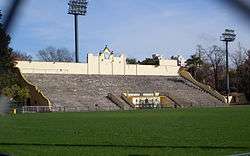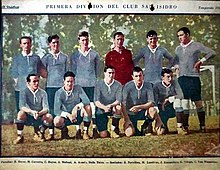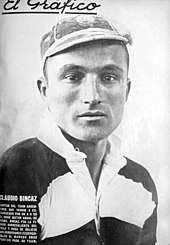Club Atlético San Isidro
The Club Atlético de San Isidro (mostly known for its acronym CASI) is an Argentine sports club based in the city of San Isidro in Greater Buenos Aires. Originally established as a football club, San Isidro has gained recognition for its rugby union team, holding a record of 33 Torneo de la URBA championships. The senior squad currently competes at Top 12, the top division of the Unión de Rugby de Buenos Aires league system.
 | |||
| Full name | Club Atlético de San Isidro | ||
|---|---|---|---|
| Union | URBA | ||
| Nickname(s) | Academia, Cebras | ||
| Founded | 24 October 1902 | ||
| Location | San Isidro, Greater Buenos Aires, Argentina | ||
| Ground(s) | San Isidro (Capacity: 5,000 [1]) | ||
| President | Jorge Allen | ||
| Coach(es) | Juan Campero y Federico Thomann | ||
| League(s) | Top 12 | ||
| 2018 | 6° | ||
| |||
| Official website | |||
| www | |||
San Isidro has also a notable past in football, with 28 consecutive seasons playing in Primera División, the top division of Argentine football league system until the club disaffiliated from the Association when the sport became professional in Argentina. Until then, San Isidro had achieved some international titles such as three Copa de Competencia Jockey Club, one Copa de Honor Municipalidad de Buenos Aires and one international Tie Cup. Nowadays, football is practised at the institution with youth and senior amateur competitions for men and women.[2]
The field hockey section has women's and men's team competing at Metropolitano championships organised by the Buenos Aires Hockey Association.
Apart from rugby, hockey and football, other disciplines hosted by San Isidro are artistic gymnastics, basque pelota, bowls, gaelic football, golf, squash, swimming, taekwondo and tennis.[3]
History
Beginning and football years


At the beginning of 1902, a group of young men started to practise football in a field placed in the lowest part of the hill (called "la barranca" in Spanish). That land was the property of María Varela de Beccar, an aristocratic woman that allowed them to play there. Nevertheless, the frequent swells of the Río de la Plata interrupted the matches many times, causing the boys to stop playing the sport they loved. This circumstance plus the adding of a wide group of football enthusiasts that joined them to play, made the boys to think about founding a club.

That group of boys was encouraged by some respectable neighbours of the zone, such as Pedro Becco or Manuel Aguirre, and even Avelino Rolón (who was Intendent of San Isidro Partido in 1906). As a result, soon after Aguirre led part of the lands for an indefinite period of time, where "Club de Foot-ball San Isidro" was founded.
By that time (May 1902) a group (formed by English natives and sons of British), most of them employees of the Central Argentine Railway also began to play football in a field next to the railroad station. Those boys founded a club naming it "San Isidro Athletic Club". Soon after that foundation, in the house of Paterson family, Mr. Hudson, McCrindle, Drenan and Ruiz; and Fernando Tiscornia, Manuel Vernet y Pedro Becco (son) as representatives of both clubs, agreed to call to a general assembly with the purpose of merging both clubs into one.
That meeting was celebrated on 24 October 1902, in the "Vignoles hotel" of San Isidro. 33 members of both clubs attended to the meeting, giving their approval to the merge of both clubs, which result was the foundation of "Club Atlético San Isidro".[4]

The club registered with the Argentine Football Association to play the Segunda División[5] until 1905 when the team promoted to the top level, Primera División.
San Isidro played all the Primera División championships from 1906[6] to 1931,[7] disaffiliating from AFA when football became professional in Argentina (although the squad remained one season in the amateur league before the two associations merged in 1934).
During its football years, San Isidro won one international title, the Tie Cup (played between the Argentine and Uruguayan champions of Copa de Competencia) in 1912, and four domestic cups: three Copa de Competencia and one Copa de Honor. Despite those honours, San Isidro could not win any Primera División championship, being runner-up in 1912, 1913, and 1915.[8][9][10]
Since then, football has been practised at CASI –at amateur level– to present, with senior, youth, children and women squads competing in the tournaments organised by the club.
Rugby union

The first rugby team of San Isidro was formed in 1908, combining British-origin employees of the Central Argentine Railway and a few Argentine-born, but it was dissolved in 1911 without having participated in any competition. Six years later, and due to an initiative by club president Rafael Cullen, San Isidro established a new rugby team, registering with the River Plate Rugby Union that same year. San Isidro won its first title in 1917, setting a record of 13 consecutive championships won (until 1930).[11]

In 1935 the club held the traditional meeting with the rival team after a match, where no women attended. During the dinner, one of the guests spilled a cup of wine over his pants, which he took off and continued eating. The rest of the players that were sat at the table showed their solidarity with him and also took their pants and continued with the dinner as if nothing had happened.
This was seen by a member of the club who related the incident to club's authorities. As a result, eleven players were suspended by CASI for periods from one to two years. Since the suspension was effective, the team lost the most games played, finishing 6th at the end of the season (Atlético del Rosario was the champion).[12]
At the end of 1935 Julio Urien was elected president of CASI for a new period, therefore the banned players left the club to found their own institution, which they called San Isidro Club (mostly known for its acronym "SIC" within rugby community). Since then, both clubs developed a strong rivalry which has remained to date.[13]
San Isidro has won 33 URBA titles and one Nacional de Clubes to date, becoming the most winning rugby union club of Argentina. Within rugby community, San Isidro is mostly known for its acronym "CASI" instead of full name.
Field hockey
San Isidro was one of the founding members of Argentine Hockey Confederation, along with Belgrano A.C. and Pacific Railway A.C..[14] The women's field hockey team won their first Metropolitano championships in the 1940s. The club inaugurated the first synthetic surface field in 2000. C.A. San Isidro currently has more than 700 players registered.[15]
Uniform evolution
Football and rugby teams have worn different uniforms through the club's history. In football, the most representative uniform was the light blue jersey, which San Isidro worn during its tenure on Argentine Primera División until the team disaffiliated from the association when football became professional.
In rugby union, San Isidro adopted its traditional colors after club's first season playing the Unión de Rugby de Buenos Aires tournament, when then president Rafael Cullen chose the black and white which have remained since.[16]
Football
|
Rugby union
|
Facilities

The rugby union team plays its home games in the rugby main field located at club's headquarters of San Isidro.[17] Nicknamed La Catedral, the stadium is the usual venue for the Torneo de la URBA finals.
Club's facilities also include a secondary rugby field, a field hockey pitch (where the women's team played its home games), several tennis courts, an association football synthetic rubber field, swimming pool, an arena for the practise of indoor football, paddle courts, billiard hall, restaurant, gym and event halls, among others.[17]
San Isidro has also four facilities, spread in San Isidro and Tigre partidos of Greater Buenos Aires.
Rivalry
CASI main rival is the San Isidro Club (SIC) since both clubs were separated. This rivalry is so strong that has been nicknamed as "The Superclásico of Argentine rugby". As of April 2019, CASI and SIC have played 130 matches, with 68 won by CASI and 52 by SIC.[18]
Highlights
- The first match played between SIC and CASI was on 9 May 1937, being SIC the winner by 3–0.
- The largest victory over SIC was a 51–7 on 25 August 2013.[19]
- The most important derby played by CASI and SIC was the final of 2005 Torneo de la URBA championship, which CASI won 18–17 with a penalty in the last minutes, after 20 years without an URBA title.
- The largest defeat against SIC was a 55–18 on 28 August 2004.
Notable former rugby players
- Antonio Bilbao La Vieja [20]
- Claudio Bincaz [21] (also a notable footballer for the club) [22]
- Arturo Rodríguez Jurado [21]
- Jorge Stewart [21]
- Ernesto Cilley [21]
- Nicanor González del Solar [lower-alpha 1] [22]
- Alejandro Puccio [23][24]
- Rodolfo O'Reilly [lower-alpha 2] [25]
- Alejandro Travaglini [26]
- Jorge Allen
- Christian Martin
- Gonzalo Beccar Varela [27]
- Eliseo Branca [28][29][30]
- Santiago Phelan[lower-alpha 3] (1992–2003)
- Agustín Pichot[lower-alpha 4] (1992–97) [31]
Honours


Football
- Copa de Competencia Jockey Club (3): 1911, 1912, 1913 [32][33][34]
- Copa de Honor Municipalidad de Buenos Aires (1): 1909 [35]
- Tie Cup (1): 1912 [36]
Rugby union
- Nacional de Clubes (1): 1995
- Torneo de la URBA (33): 1917, 1918, 1920, 1921, 1922, 1923, 1924, 1925, 1926, 1927, 1928, 1929, 1930, 1933, 1934,
1943, 1949, 1954, 1955, 1956, 1957, 1960, 1961, 1962, 1964, 1967, 1974, 1975, 1976, 1981, 1982, 1985, 2005
Field hockey
Men's
- Metropolitano Primera División (4): 1908, 1921, 1926, 1948
Women's
- Metropolitano Primera División (5): 1943, 1944, 1966, 1967, 1969
Notes
- After retiring he became a rugby journalist.
- Also head coach and Secretary of Sports of Argentina.
- Former Argentina national team head coach.
- Also former captain of Los Pumas.
References
- Estadios de Argentina
- Fútbol en el club
- Deportes on CASI website, retrieved 13 Apr 2019
- "Historia del club", official site
- "Argentina – Second Level 1903" at RSSSF
- Argentina 1906 at RSSSF
- "Asociación Amateurs Argentina de Football: Copa Campeonato" – RSSSF
- Argentina – Primera División 1912 at RSSSF
- Argentina – Primera División 1913 at RSSSF
- Argentina – Primera División 1915 at RSSSF
- Historia del Rugby Argentino (1917–30) by Hugo Mackern (1986)
- Historial de Torneos at URBA webpage
- "SIC: El alumbramiento", La Nación, 12 July 2005
- Historia del Hockey, I Parte: Una trilogía para la historia by Eric Weil (Archive, 10 Dec 2008)
- Reseña histórica de hockey on CASI website, 14 Nov 2016
- "Reseña histórica del rugby" at official website
- Sedes e Instalaciones on CASI website
- Más desparejos que nunca by Agustín Monguillot, La Nación, 12 Apr 2019
- "El CASI le dio una paliza al SIC en el clásico de San Isidro", Clarín, 25 August 2013
- "El pasado del rugby vive en San Isidro", La Nación, 20 March 2008
- "La historia viva del rugby", Clarín, 21 October 2002
- "Gloriosa academia de campeones", La Nación, 24 October 2002
- "Ese campeón, esa alegría grande" by Jorge Búsico
- "Uno menos en el clan Puccio: murió Alejandro" Archived 4 March 2016 at the Wayback Machine, Los Andes, 1 Jul 2008
- "Rodolfo O’Reilly, una visita que llenará de orgullo al rugby local", at CordobaXV.com, 22 February 2011 Archived 8 October 2013 at Archive.today
- "Travaglini's profile at UAR website". Archived from the original on 20 February 2015. Retrieved 8 October 2013.
- "Un doble regalo", La Nación, 22 May 2011
- "Branca, un símbolo" at Periodismo-Rugby.com
- "Eliseo Branca dijo basta" at Infobae.com, 13 December 2005
- "Branca, entre Los Pumas y CASI", ESPN, 22 September 2010
- "Pichot se despide con su barra", Página/12, 27 June 2009
- Copa de Competencia Jockey Club 1911 results
- Copa de Competencia Jockey Club 1912 results
- Copa de Competencia Jockey Club 1913 results
- 1909 Copa de Honor – RSSSF
- Cup Tie of 1912 – RSSSF

